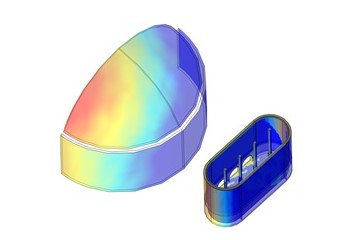SC Solutions delivered to East Bay Municipal Utility District (EBMUD) the results of a thermal analysis of the containment structure of their waste gas burners. EBMUD’s Main Wastewater Treatment Plant (MWWTP) in Oakland, CA operates a digester facility where biodegradable wastes in sewage, food scraps and grease from local restaurants are mixed together with other organic waste streams in large tanks and “digested” by anaerobic microorganisms. The biogas emitted by the process is captured and burned in gas turbines and engines to power the wastewater treatment plant. Excess gas is burned in either four external flares (waste gas burners), or two enclosed flares. The containment structure around the external flares (wall and the interior refractory) is planned to be replaced as part of an upgrade process underway in Spring 2021. In this project, SC worked closely with the EBMUD engineers to perform a detailed thermal analysis of the structure. The goal of this work was to estimate the structure temperatures during normal and peak load operation in order to evaluate the ability of the new refractory liner to protect the concrete structure from the heat produced by the flares.
The refractory and concrete are heated by the flames. Radiative heat transfer is the dominant heat transport mechanism here because of the high temperatures involved. There is conduction heat transfer within the walls and convective losses from the walls to the surrounding air. The heat transfer rates change with time because of changing ambient conditions as well as changes in gas flow rates. In addition, the walls have a large thermal mass that causes heating and cooling of the structure to occur over many hours. Hence, the heat transfer problem is inherently transient.
We developed a time-varying, three-dimensional (3D) thermal model of the flare containment structure for EBMUD using the commercial FEM package, COMSOL Multiphysics. The FEM model was verified by developing another model with identical attributes in SC’s in-house software that uses a different numerical method. Separate finer-scale models of individual wall panels were developed to verify that simplifications adopted to make the heat transfer problem tractable were indeed justifiable. The model incorporated time-varying directional solar heating and daily ambient temperature variation throughout the year. A shell representing the biogas generator dome was added to the model to incorporate its shadowing effect on the solar irradiance incident to the flare containment walls.
The heat transfer model inputs include the thermal properties of the materials. While some of these properties are known with sufficient accuracy (e.g., densities, thermal conductivities and specific heat capacities of concrete and refractory) others are more uncertain (e.g., surface emissivities, heat transfer to the ground). The preliminary COMSOL model was used to run simulations to test the sensitivity of the wall temperatures to these properties (sensitivity analysis for uncertain parameters). The nominal choices for these properties were made based on data in the literature. The FEM model was then calibrated using temperature measurements and corresponding operating conditions that were provided by EBMUD. The calibration process involved adjusting the properties (model parameters) to which the wall temperatures have the highest sensitivity until the model prediction matched the measured temperatures.
The model was run to simulate four days of continuous operation to estimate the maximum wall temperatures. One worst-case scenario was simulated as continuous operation during the hottest days of summer. Another scenario involved operation at a very high rate of gas flow rate for four hours following continuous operation at the nominal flow rate. The simulation results yielded maximum temperatures in the refractory and the concrete walls that will be used for design modifications and material selection for a new containment structure.
